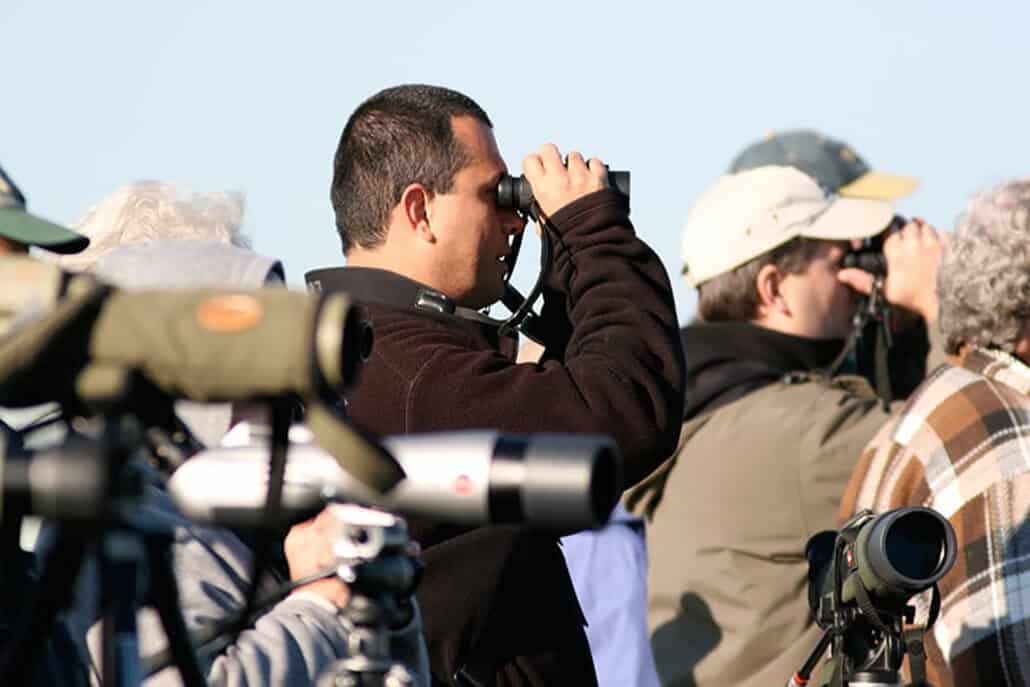The best binoculars in the world are useless i. You know the story. You left them home because they were too heavy and you weren’t intending to go birding anyway.
But birds can turn up anywhere, any time. A black-throated blue warbler might materialize in the mall’s parking-lot shrubbery. Or a tufted duck could wander in from Europe and light on the river you drive across every day on the way to work.
But what if there were binoculars so small and light that you always had them with you? Something that would take up almost no room in your purse or pocket but still had excellent optics and rugged construction? You would always be ready and never miss a bird. Sound good? Then welcome to the world of pocket optics.
We collected 38 pocket binoculars from 17 manufacturers and assembled a team of southeast Iowa birders to try them out. We limited the entrants to those weighing less than 13 ounces. The lightest was only 5-1/4 ounces. All might fit into some sort of pocket, and a few can actually be carried in a shirt pocket. None of the binoculars we tested was over 4-1/2 inches long. They fell into two groups, roof prism design and reverse Porro prism design.
The smallest binoculars we tested were all roof prism design, in which the front lenses and the eyepieces are in a straight line. Roof prism binoculars are naturally compact. And furthermore, most of the pocket roofs can fold even smaller when not in use. The Porro prism group averaged somewhat larger.
Although regular Porro prism binoculars have an obvious zigzag shape with the front lenses wider apart than the eyepieces, reverse Porros have the front lenses closer together than the eyepieces. This allows for a more compact package.
Limitations of pocket binoculars
Are there tradeoffs for pocket convenience? Does everything look smaller? No, pocket binoculars can magnify the bird just as much as full-sized models. And the image can be just as sharp and clear.
However, there are some limitations. Their small objective lenses, usually only 20 to 25 millimeters in diameter, cannot deliver as bright an image in dim light as can binoculars with 42mm objectives. But in ordinary daylight, assuming they have good optics and lens coatings, pocket binoculars will seem just as bright as their larger cousins.
The field of view is often narrower, but not always. Field of view is actually related not to size, but to eyepiece design. For example the Pentax DCF binoculars offer a 330-foot field of view at 1,000 yards both with the standard-size 8×42 model and with the pocket 8×22 model.
Size and Weight
Smaller is better as long as the binoculars work ergonomically for you. They should provide no excuse to ever leave them behind. Although all the binoculars we reviewed are small, the 8×20 roof prism binoculars by Leica, Swarovski, and Zeiss and Nikon’s 7×15 Titanium are the tiniest.
Optical and Build Quality
You want binoculars that deliver sharp, bright, color-true images. Nitrogen-filled binoculars resist fogging up inside. Fully multicoated lenses preserve most of the light coming through the optics and therefore give a bright image. In roofprism binoculars, phase-corrected prism coatings provide an image with high contrast. High-quality construction will help keep the optics in alignment.
Close Focus and Field of View
Many birders will weigh a model’s ability to focus up close, especially if they also like to watch butterflies. Bird watchers who like to seek warblers among dense foliage may find that a wide field of view makes it easier to locate their prey.
Eye Relief
If you wear glasses, consider the eye relief, or the maximum distance that you can hold the binoculars from your eye and still see the whole picture. Some of our glasses-wearing judges found that binoculars offering more than 13mm of eye relief let them see the whole picture, not just the center of the circle. Others needed at least 16mm. The 18mm of eye relief offered by Eagle Voyager, Opticron, and Brunton worked for everyone.
Waterproofing
Anyone who has ever had a pair of treasured binoculars go for a sudden, unexpected dip in a puddle or pond will tell you that waterproofing can make the difference between binoculars that survive and those that don’t. Some are rated “water resistant,” which means that they can be sprinkled but not submerged.
Eyecups
Do you ever share your binoculars with someone whose glasses status differs from yours? If the eyecups pop out or twist up, it takes only a fraction of a second to convert the binoculars back and forth between someone who wears glasses and someone who does not. If the eyecups are the rubber style that must be folded over like the cuff of a sock, the job will require full concentration and the use of both hands, and it may take 5 to 10 seconds.
No problem if you’re looking at waterfalls. But for birders who wish to see a rare and wonderful bird that has just appeared unexpectedly, swift-converting eyecups might be a deciding factor in which binoculars to buy.
Straps
Even the neck strap can make a difference in the pleasure derived from binoculars. Many of the pairs we considered came with a braided cord of 1/8-inch diameter or less. While such a narrow cord is quite sufficient to suspend the bantam weight of the binoculars, one of our T-shirt-wearing judges thought that the cords might become uncomfortable against the bare neck.
Dangle Factor
Something we never thought about until we tested the pocket binoculars is the position that they assume when worn suspended by their straps. Some hang straight up and down. These are generally well behaved during a brisk walk. We labeled them straight in the Dangle Factor column of the chart.
Others hang at an angle, with the eyepieces toward the victim’s belly. Some of the judges found that such binoculars tended to give a little nudge in the ribs with every step. We identify them as head-in. A few hang with the objective lenses rather than the eyepieces toward the wearer’s body.
We labeled these toe-in. Although toe-in binoculars also bounced around with the wearer’s steps, unless the angle was extreme, they tended to hug the belly and seemed to ride more comfortably than the head-in specimens.
Ergonomics
The fit-and-feel factor looms large in pocket roof prism binoculars because of their exceptionally small sizes. Some judges found the tiniest specimens too small to hold comfortably. And the focus knobs can be small or located in unexpected places.
Although design was not much of an issue with the reverse Porro prism models, which are more normal in size and layout, the testers diverged considerably over which roof prism designs they preferred. With pocket roof prism binoculars, you might want to try them out to see if they fit your hands.
Putting it all together
We like binoculars with bright, sharp optics, fully multi-coated lenses, and phase coatings if it’s a roof prism pair. We want it to focus close, give us plenty of eye relief, and provide a wide field of view.
We want our binoculars to be waterproof, nitrogen filled, lightweight, and have a pleasant, non-slip surface to hold on to. We go for pop-up or twist-out eyecups and a comfortable strap. Of course the binocs must be small and fit in the breast pocket of a shirt. Oh, yes, and we’d like them to be inexpensive.
Of course, there is no such animal. The skill of choosing binoculars is a matter of picking one’s priorities and selecting the instrument that delivers what you care the most about.




